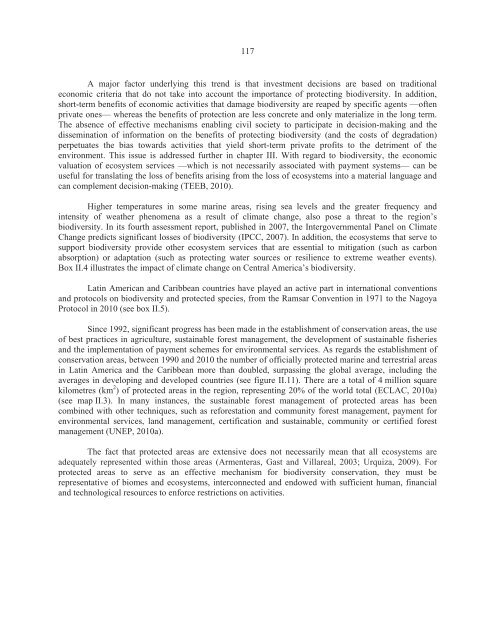sustainable development 20 years on from the ... - José Eli da Veiga
sustainable development 20 years on from the ... - José Eli da Veiga
sustainable development 20 years on from the ... - José Eli da Veiga
You also want an ePaper? Increase the reach of your titles
YUMPU automatically turns print PDFs into web optimized ePapers that Google loves.
117<br />
A major factor underlying this trend is that investment decisi<strong>on</strong>s are based <strong>on</strong> traditi<strong>on</strong>al<br />
ec<strong>on</strong>omic criteria that do not take into account <strong>the</strong> importance of protecting biodiversity. In additi<strong>on</strong>,<br />
short-term benefits of ec<strong>on</strong>omic activities that <strong>da</strong>mage biodiversity are reaped by specific agents —often<br />
private <strong>on</strong>es— whereas <strong>the</strong> benefits of protecti<strong>on</strong> are less c<strong>on</strong>crete and <strong>on</strong>ly materialize in <strong>the</strong> l<strong>on</strong>g term.<br />
The absence of effective mechanisms enabling civil society to participate in decisi<strong>on</strong>-making and <strong>the</strong><br />
disseminati<strong>on</strong> of informati<strong>on</strong> <strong>on</strong> <strong>the</strong> benefits of protecting biodiversity (and <strong>the</strong> costs of degra<strong>da</strong>ti<strong>on</strong>)<br />
perpetuates <strong>the</strong> bias towards activities that yield short-term private profits to <strong>the</strong> detriment of <strong>the</strong><br />
envir<strong>on</strong>ment. This issue is addressed fur<strong>the</strong>r in chapter III. With regard to biodiversity, <strong>the</strong> ec<strong>on</strong>omic<br />
valuati<strong>on</strong> of ecosystem services —which is not necessarily associated with payment systems— can be<br />
useful for translating <strong>the</strong> loss of benefits arising <strong>from</strong> <strong>the</strong> loss of ecosystems into a material language and<br />
can complement decisi<strong>on</strong>-making (TEEB, <str<strong>on</strong>g>20</str<strong>on</strong>g>10).<br />
Higher temperatures in some marine areas, rising sea levels and <strong>the</strong> greater frequency and<br />
intensity of wea<strong>the</strong>r phenomena as a result of climate change, also pose a threat to <strong>the</strong> regi<strong>on</strong>’s<br />
biodiversity. In its fourth assessment report, published in <str<strong>on</strong>g>20</str<strong>on</strong>g>07, <strong>the</strong> Intergovernmental Panel <strong>on</strong> Climate<br />
Change predicts significant losses of biodiversity (IPCC, <str<strong>on</strong>g>20</str<strong>on</strong>g>07). In additi<strong>on</strong>, <strong>the</strong> ecosystems that serve to<br />
support biodiversity provide o<strong>the</strong>r ecosystem services that are essential to mitigati<strong>on</strong> (such as carb<strong>on</strong><br />
absorpti<strong>on</strong>) or a<strong>da</strong>ptati<strong>on</strong> (such as protecting water sources or resilience to extreme wea<strong>the</strong>r events).<br />
Box II.4 illustrates <strong>the</strong> impact of climate change <strong>on</strong> Central America’s biodiversity.<br />
Latin American and Caribbean countries have played an active part in internati<strong>on</strong>al c<strong>on</strong>venti<strong>on</strong>s<br />
and protocols <strong>on</strong> biodiversity and protected species, <strong>from</strong> <strong>the</strong> Ramsar C<strong>on</strong>venti<strong>on</strong> in 1971 to <strong>the</strong> Nagoya<br />
Protocol in <str<strong>on</strong>g>20</str<strong>on</strong>g>10 (see box II.5).<br />
Since 1992, significant progress has been made in <strong>the</strong> establishment of c<strong>on</strong>servati<strong>on</strong> areas, <strong>the</strong> use<br />
of best practices in agriculture, <str<strong>on</strong>g>sustainable</str<strong>on</strong>g> forest management, <strong>the</strong> <str<strong>on</strong>g>development</str<strong>on</strong>g> of <str<strong>on</strong>g>sustainable</str<strong>on</strong>g> fisheries<br />
and <strong>the</strong> implementati<strong>on</strong> of payment schemes for envir<strong>on</strong>mental services. As regards <strong>the</strong> establishment of<br />
c<strong>on</strong>servati<strong>on</strong> areas, between 1990 and <str<strong>on</strong>g>20</str<strong>on</strong>g>10 <strong>the</strong> number of officially protected marine and terrestrial areas<br />
in Latin America and <strong>the</strong> Caribbean more than doubled, surpassing <strong>the</strong> global average, including <strong>the</strong><br />
averages in developing and developed countries (see figure II.11). There are a total of 4 milli<strong>on</strong> square<br />
kilometres (km 2 ) of protected areas in <strong>the</strong> regi<strong>on</strong>, representing <str<strong>on</strong>g>20</str<strong>on</strong>g>% of <strong>the</strong> world total (ECLAC, <str<strong>on</strong>g>20</str<strong>on</strong>g>10a)<br />
(see map II.3). In many instances, <strong>the</strong> <str<strong>on</strong>g>sustainable</str<strong>on</strong>g> forest management of protected areas has been<br />
combined with o<strong>the</strong>r techniques, such as reforestati<strong>on</strong> and community forest management, payment for<br />
envir<strong>on</strong>mental services, land management, certificati<strong>on</strong> and <str<strong>on</strong>g>sustainable</str<strong>on</strong>g>, community or certified forest<br />
management (UNEP, <str<strong>on</strong>g>20</str<strong>on</strong>g>10a).<br />
The fact that protected areas are extensive does not necessarily mean that all ecosystems are<br />
adequately represented within those areas (Armenteras, Gast and Villareal, <str<strong>on</strong>g>20</str<strong>on</strong>g>03; Urquiza, <str<strong>on</strong>g>20</str<strong>on</strong>g>09). For<br />
protected areas to serve as an effective mechanism for biodiversity c<strong>on</strong>servati<strong>on</strong>, <strong>the</strong>y must be<br />
representative of biomes and ecosystems, interc<strong>on</strong>nected and endowed with sufficient human, financial<br />
and technological resources to enforce restricti<strong>on</strong>s <strong>on</strong> activities.













